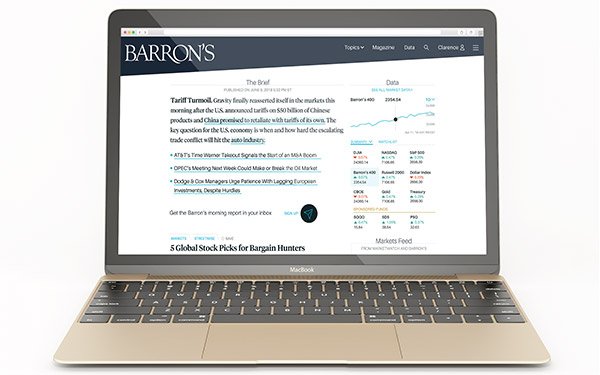
Barron’s, a
financial and investment magazine under Dow Jones Media Group, has redesigned its website, inspired by the clean and direct nature of newsletters.
The homepage design features "The
Brief" at the top to tell readers “how to think about today and forecasting tomorrow," Daniel Bernard, senior vice president of Barron's, told Publishers Daily.
It summarizes the market news of the day and what it means for the future, with bullet points and headlines for readers to click to read deeper, much like a newsletter. It is part of a
larger move to improve the Barron’s homepage.
Brighthouse Financial is one of Barron’s launch partners for the redesign.
"On weekdays, Barron's readers
are inundated with information,” said editor-in-chief Katherine Bell. “They trust us to sort the signal from the noise, to put the news in context and explain its potential
consequences.”
advertisement
advertisement
The nearly 100-year-old title has over 500,000 subscribers, mostly comprised of wealthy, professional investors. Online, its content is behind a paywall —
the minimum number of articles a reader can consume is based on an algorithm, a flexible wall that spans across all of Dow Jones’ publications.
“The Dow Jones Media Group
is reimagining legacy brands and bringing them to the modern age,” Almar Latour, publisher of Dow Jones Media Group, told Publishers Daily.
The goal of the
Barron’s redesign is to “grow membership, grow advertisers, and grow audience,” he added.
The redesign team found readers wanted more information on emerging technology
“driving disruption, and what that means for your investments, your investing strategy or how you are advising your clients,” Bernard explained.
Editorial is now
organized by “interests,” which are “more granular” than sections, Bernard said. “Technology” and “sustainable investing” are two of the interests
listed.
Topics can be added and tweaked based on what news is trending.
Readers will notice substantially fewer images on the new Barron’s site. The team
found that using stock photography for financial news (generic images of rising stocks) did not drive engagement from its audiences.
The result is a decluttered, less noisy page; the
trimming down of columns also gives the homepage a cleaner look. Less artwork means more focus on the headlines, and any original photography Barron’s has.
Less photography
means display advertising “exists in a cleaner environment,” Bernard said, and in some ways is “the pop and color of the site. Ads actually shine more,” he said. “We are
expecting an uplift with ads.”
Cleaning up the site does not affect Barron’s online ad inventory online.
The Barron’s logo and navigation menu now
sit in the “wedge.” The full-bleed header shape can feature a flexible ad that moves with the browser size, and also has the ability to push down or takeover the page.
A
new “Sponsored Funds” section underneath the market data widget of the site “puts the product in front of users" with a ticker for sponsored products. It acts like a native, product
placement, Bernard said.
Barron’s also got rid of its infinite scroll feature, a popular way for publishers to serve its readers article after article. Instead, readers
are given packages of about eight-to-10 articles on news related to the original article they clicked on - a continuous, finite news scroll, integrated with native advertising.
Each
article rolls into the next. After the last article in the package, it reads: “The End.”
Barron’s will also roll out digital covers. The bold, print-like
cover story, image and headline will bring attention to its weekend edition and feature stories.
“When the market is closed on the weekend, we know our readers like to take the
time to consider issues more deeply and think about the big picture, so we made the weekend experience a lot more immersive,” Bell said.
Digital covers are a full-bleed banner
photo and headline across the top of the site, with an “Open” button that pushes down the rest of the homepage with the article. Once a reader is finished, they can “X” out of
the story, and get right back to where they were on the original page.
Latour said brands like Barron's need to “grow with” its audience, “and bring the same
approach to digital presentation and advertising as we are to financial information.”
Dow Jones Media Group oversees the luxury and financial titles Barron's, MarketWatch,
Mansion Global and Financial News, as well as Penta, the luxury lifestyle accompaniment to Barron’s.
Created in 2016, Dow Jones Media Group acts
like the start-up arm of Dow Jones, with more room to innovate, experiment and test ideas for digital growth. The Dow Jones Media Group was behind the recent launch of millennial personal finance
brand Moneyish.